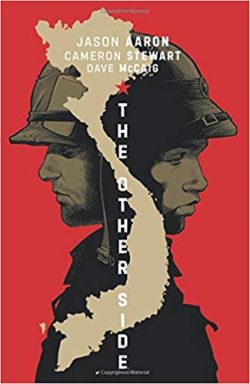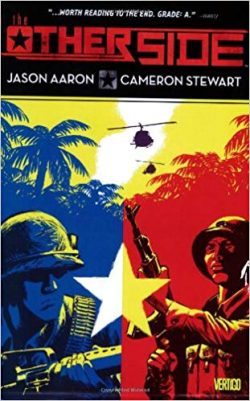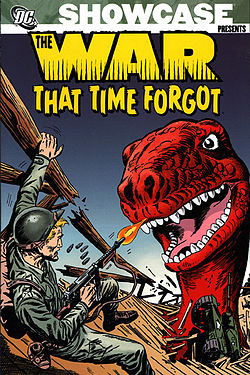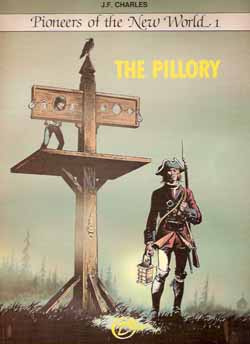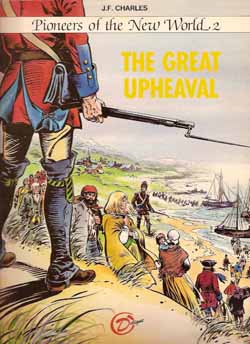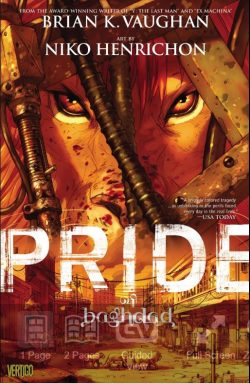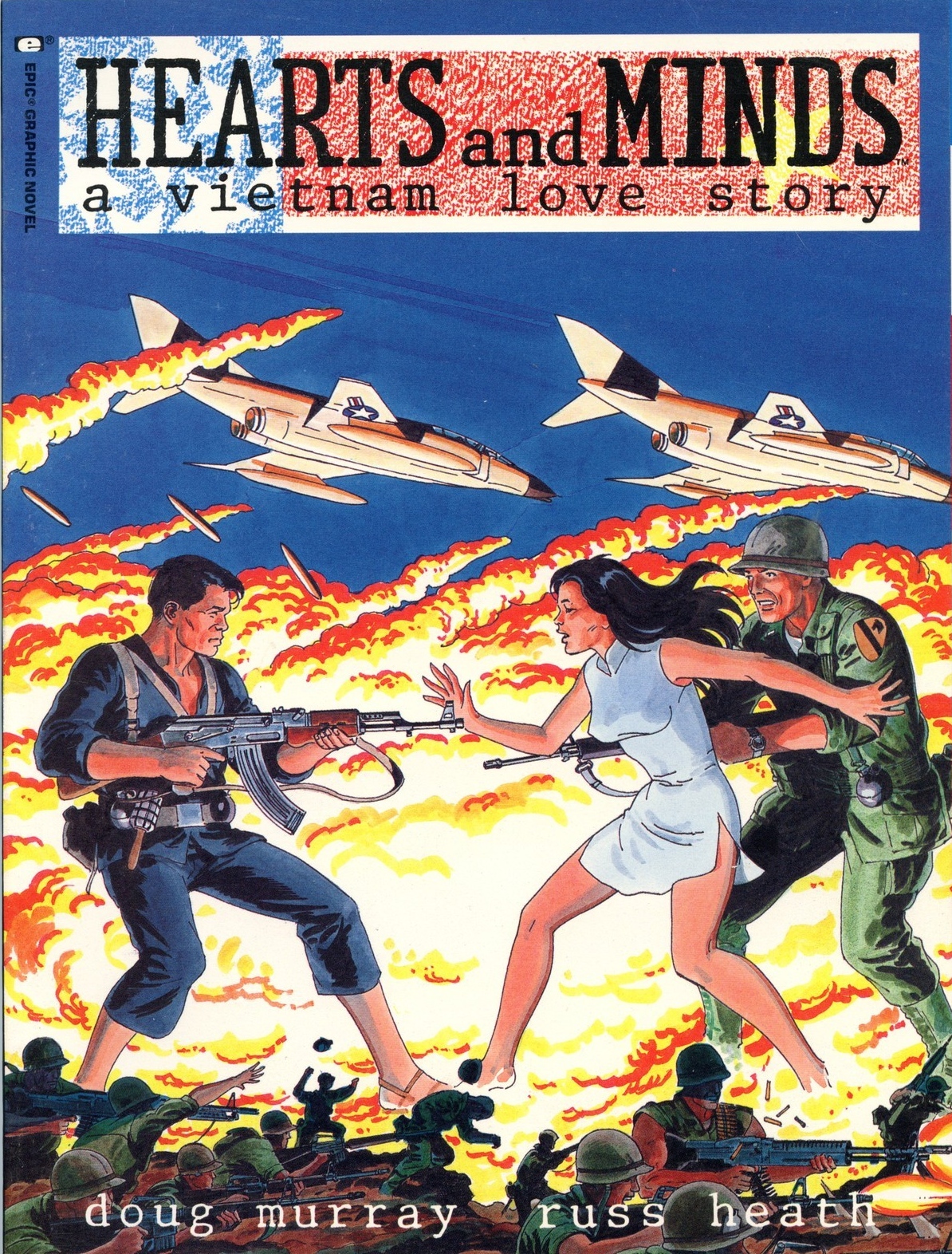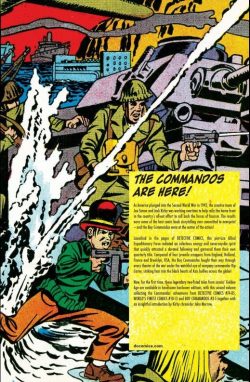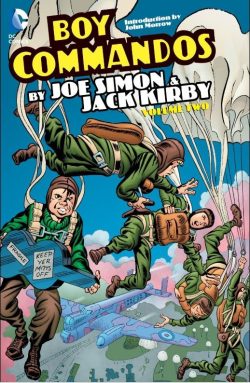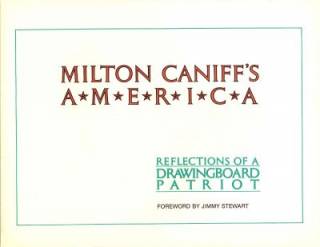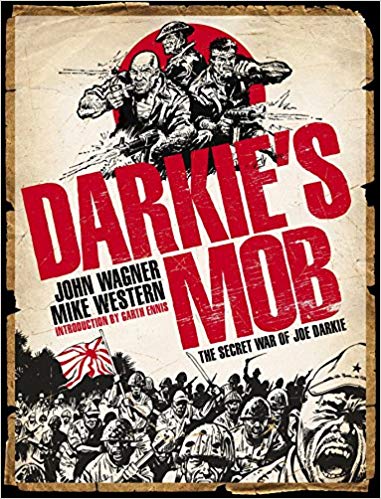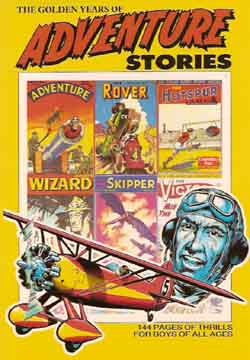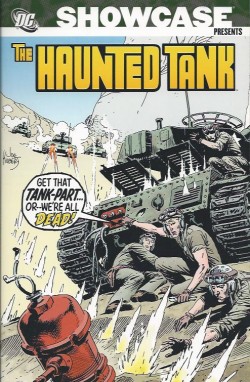
By Robert Kanigher, Russ Heath, Irv Novick, Joe Kubert, Sam Glanzman, Ross Andru, Doug Wildey & various (DC Comics)
ISBN: 978-1-4012-0789-8
Robert Kanigher (1915-2002) was one of the most distinctive authorial voices in American comics, blending rugged realism with fantastic fantasy in his signature war comics. He also exceled in horror stories, westerns and superhero titles such as Wonder Woman, Teen Titans, Hawkman, Metal Men, Batman and many others too numerous to cover here.
Kanigher sold his first stories and poetry in 1932, wrote for the theatre, film and radio, and joined the Fox Features shop where he created The Bouncer, Steel Sterling and The Web, whilst providing scripts for Blue Beetle and the original Captain Marvel.
In 1945 he settled at All-American Comics as both writer and editor, staying on when the company amalgamated with National Comics to become the forerunner of today’s DC. He wrote Flash (Jay Garrick) and Hawkman, created Black Canary and Lady Cop, and so many memorable villainesses such as Harlequin and Rose and the Thorn. This last terrible temptress he redesigned during the relevancy era of the early 1970s into a schizophrenic crime-busting super-heroine who haunted the back of Superman’s Girlfriend Lois Lane, which Kanigher also scripted.
When mystery-men faded out at the end of the 1940s, Kanigher moved into westerns and war stories, becoming in 1952 writer/editor of the company’s combat titles: All-American War Stories, Star Spangled War Stories and Our Army at War.
He created Our Fighting Forces in 1954 and added G.I. Combat to his burgeoning portfolio after Quality Comics sold their line of titles to DC in 1956, all the while working on Wonder Woman, Johnny Thunder, Rex the Wonder Dog, Silent Knight, Sea Devils, Viking Prince and a host of others.
In 1956 he scripted ‘Mystery of the Human Thunderbolt’; the first story of the Silver Age which introduced Barry Allen as the new Flash to hero-hungry kids of the world.
Kanigher was a restlessly creative writer and frequently used his uncanny but formulaic adventure arenas as a testing ground for future series concepts. Among the many epochal war features he created were Sgt. Rock, Enemy Ace, The War that Time Forgot and The Losers as well as the irresistibly compelling “combat ghost stories†collected here in this second stupendously expansive war-journal.
This terrific monochrome tome re-presents more blockbusting exploits of boyhood friends Jeb Stuart Smith, Arch Asher, Slim Stryker and Rick Rawlins (from G.I. Combat #120-156, October/November 1966 to October/November 1972) from a period during which superheroes rose to astonishing global dominance before almost vanishing into comicbook Valhalla once more.
Apparently immune to such tenuous trendiness, the battle-hardened veterans of the M-3 Stuart Light Tank – named for the legendary Confederate Army General who was a genius of cavalry combat, and haunted by his restless spirit – soldiered on, battling threats mortal and frequently metaphysical on many fronts during World War II. The series became – after Sgt. Rock – DC’s most successful and long-lived combat feature.
The tales were generally narrated by Jeb as he manned the Commander’s spotter-position (head and torso sticking out of the top hatch and completely exposed to enemy fire whilst driver Slim, gunner Rick and loader Arch remained relatively safe inside), constantly conversing with his spectral namesake who offered philosophy, advice and prescient, if often obscurely veiled, warnings …
Throughout the early days Jeb’s comrades continually argued about what to do with him. Nobody believed in the ghost and they all doubted their commander’s sanity, but since he began seeing the General, Stuart Smith had become a tactical genius and his “gifts†were keeping them all alive against incredible odds…
This volume opens with G.I. Combat #120 ‘Pull a Tiger’s Tail!’ – illustrated by Irv Novick – detailing how, after accompanying both Sgt. Rock and Navajo fighter-pilot Johnny Cloud on sorties, Jeb defies orders to capture a giant Tiger tank his own way…
Another spiritually-sponsored warrior, Cloud regularly communed with a mounted Indian Brave dubbed Big-Brother-in-the Sky, galloping across the heavens during his own high-flying missions.
The inspirational Russ Heath illustrated #121’s ‘Battle of Two Wars!’ wherein, after rescuing a shell-shocked pigeon, the tankers are inexplicably drawn back to WWI to save Sgt Rock’s father. He then returns the favour once the Stuart returns to its proper time, whilst in ‘Who Dies Next?’ (#122, with art by Novick), the General issues a dire proclamation that one of their own will not last the day out – a forecast that comes true in a most shocking manner…
Heath returned to the art with #123’s ‘The Target of Terror!’ as guest star Mlle. Marie returned with news of a secret weapon to be destroyed at all costs. Sadly, the French Resistance leader has partial amnesia and doesn’t remember exactly what or where…
In follow-up ‘Scratch that Tank!’ the crew’s shiny new replacement vehicle is a cause of acute embarrassment until it finally gains a few praiseworthy combat scars…
G.I. Combat #125 decrees ‘Stay Alive… Until Dark!’ as Jeb’s sorely reduced battle-group attempts to hold too much ground with too few tanks, culminating in a Horatian last stand in the shattered, cloistered streets of a tiny French town, after which the crew endure deadly desert warfare in a desperate search for Panzers hidden by a cunning ‘Tank Umbrella!’
Novick illustrated the gritty ‘Mission – Sudden Death!!’ in #127 as Mlle. Marie leads the tank-jockeys far from their combat comfort zone on an infantry raid to rescue her captured father, after which Heath returned to limn ‘The Ghost of the Haunted Tank!’
This superbly evocative thriller reveals the crew finally cracking during a brutal massed Panzer assault and restraining their clearly delusional commander for his own good. However, when solid, no-nonsense Slim takes the observer’s spot he too starts seeing the spectral sentinel and is forced to act on the apparition’s strategic advice…
Issue #129 is pure Kanigher poesy as ‘Hold that Town for a Dead Man!’ depicts the tankers rolling past an American soldier expired at his post, and swearing to eradicate the foes who felled him…
When the blistering cat-and-mouse duel seems to go against the crew they are saved by an impossible burst of gunfire fired by a cold, stiff hand…
In the afterlife all great military commanders sponsor mortal combatants. General Stuart is stuck looking after a pack of “Damned Yankeesâ€, but the other side also has phantom patrons. G.I. Combat #130 sees the return of savage shade Attila the Hun, who directly attacks his revenant rival in a deadly ‘Battle of the Generals!’ Jeb can only watch helplessly whilst trying to save his tank from mundane but just as murderous German panzer, artillery and air attacks, until…
Their next mission took the crew and a band of savage child-warriors into the heart of Paris to rescue Mlle. Marie from the Gestapo in #131’s ‘The Devil for Dinner!’ The short-lived and extremely controversial Kid Guerrillas of Unit 3 had debuted in the Sgt. Rock tale from Our Army at War #194, June 1968.
Mike Sekowsky & Joe Giella stepped in to illustrate the follow-up wherein the Belle of La Resistance leads Jeb and the boy-soldiers – bizarrely disguised as a circus troupe – against merciless SS leader ‘The Executioner!’
The artists stayed on for #133’s ‘Operation: Death Trap’ as the Haunted Tank and crew are parachuted into North Africa to liberate enslaved natives working in a German diamond mine, before – following a ‘Special Battle Pin-up’ of the tankers by Joe Kubert – Ross Andru & Mike Esposito signed up for a stint, beginning with ‘Desert Holocaust’ wherein the tankers deal out vengeance for the three MacBane brothers; sibling tank-commanders slaughtered by the Afrika Korps.
Continuity was never a big concern for Kanigher and stories would often occur in no logical or chronological order. In #135 the lads are suddenly back in France, battling paratroopers and air-lifted Panzers with only aged WWI survivors to aid them in ‘Death is the Joker’, whilst ‘Kill Now – Pay Later!’ pits Tank against U-Boat and Jeb against its driven doom-obsessed Kommander in an improbable duel, before Heath returned in #137 to illustrate the African adventure ‘We Can’t See!’ Here the Americans are all temporarily blinded but nevertheless succeed in destroying a poison gas cache thanks to aid of a little Arab boy.
Kanigher often used his stories as a testing ground for new series ideas. G.I. Combat #138 introduced one of his most successful in ‘The Losers!’, when the Armoured Cavalry unit encounter a sailor, two marines and old friend Johnny Cloud, all utterly demoralised after losing the men under their respective commands.
Inspired by Jeb and a desire for revenge, the crushed survivors regain a measure of respect and fighting spirit after surviving a certain suicide-mission and destroying a Nazi Radar tower…
The new team were formed by amalgamating three old war series together. Gunner and Sarge (latterly supplemented by Pooch, the Fighting Devil Dog) were Pacific-based Marines debuting in All-American Men of War #67, March 1959 and running for fifty issues in Our Fighting Forces (#45-94, May 1959-August 1965).
Captain Johnny Cloud was a native American fighter pilot who shot down his first bogie in All-American Men of War #82. The “Navaho Ace†flew solo until issue #115, (1966) whilst Captain Storm was a disabled PT Boat skipper who fought on despite having a wooden left leg in his own eponymous 18-issue series from 1964 to 1967. All three series were originally created by comics warlord Kanigher and The Losers swiftly returned as an elite unit of suicide-soldiers starring in Our Fighting Forces.
G.I. Combat #139 again saw the Haunted Tank parachuted into an Arabian nightmare when the crew interrupt a funeral and save the widow from being forced onto the pyre with her deceased husband. ‘Corner of Hell’ finds Jeb wedding and losing his bride to Nazi sympathizers and an ancient prophecy…
Issue #140 featured a reprint not included here – although the new Kubert introduction page is – before the graphic narratives resume with ‘Let me Live… Let me Die!’ wherein Kanigher & Heath confront the topics of race and discrimination in a powerful tale describing the plight of African-American soldiers who were used as porters, gravediggers and ammunition carriers, but forbidden from bearing or actually using arms.
When Jeb arrives at a recently decimated ammo dump, the sole survivor of the Segregated Negro unit demands to accompany the crew and be allowed to fight and die like a man. Rushing to reinforce Sgt. Rock’s Easy Company and despite the thinly veiled disdain of Slim, Arch and Rick, when Jeb is wounded the valiant tag-along finally gets his chance…
G.I. Combat #142 finds Jeb obsessed with the moment of his own death in ‘Checkpoint – Death!’ but when the General isn’t forthcoming soon forgets it as an unseasonal snowstorm turns the world into a frozen hell…
‘The Iron Horseman!’ sees a frustrated WWI tanker finally get a chance to be a hero when Panzers attack a convent and Jeb’s crew are ambushed. There follows an informational spread ‘Battle Album: General Stuart Light Tank M31A’ – by Kubert – before #144 reveals a retrofitted Heath-illustrated origin for the Haunted Tanker in ‘Every Man a Fort!’
Now with Jeb a Northern Yankee, the tale reveals how he has to win with his fists the respect of pure-bred Southerners Rick, Slim and Arch before they let him call himself Jeb Stuart, and cements that bond during their first foray under fire in North Africa…
The desert milieu continued in #145’s ‘Sun, Sand & Death!’ when a sandstorm forces the tank off-course and leads them to an abandoned B-25 bomber, giving the dying pilot a chance to redeem his lost honour, whilst #146 sees the M-3 and its crew endure debilitating hazards battling the Afrika Korps but still persevering when the General advises Jeb to ‘Move the World!’…
For some Americans the wounds of the Civil War still festered, as Jeb discovers when he encounters the hostile commander of a ‘Rebel Tank’ in #147. Of course, the Germans are happy to remind the feudsters who is currently doing all the shooting, after which in #148 ‘The Gold-Plated General!’ (a thinly disguised analogue of George S. “Blood and Guts†Patton) demands a spit-and-polish war, but even under combat conditions leads by painful example…
American services discrimination was again confronted in G.I. Combat#149 when a Jewish soldier joins the division in ‘Leave the Fighting to Us!’ Many of the good guys have to eat their words when the tank group liberates a Nazi concentration camp…
A major visual change came in #150 with ‘The Death of the Haunted Tank!’ This saw the M-3 destroyed in combat and the crew jury-rigging a jigsaw replacement from the remnants of other scrapped and abandoned but, unsurprisingly, bigger, more powerful vehicles.
Proving again that men and not the machine are the heart of the partnership, the General sticks around and when the new Haunted Tankers passes through an alpine village they eerily relive a mediaeval battle against barbarian invaders in #151’s ‘A Strong Right Arm!’ before bringing a Nazi infiltrator aboard who turns their homemade rolling fortress into a deadly ‘Decoy Tank’ to lure Allied forces into an ambush…
Comics and animation legend Doug Wildey replaced Heath for #153 as sentimental fool Jeb adopts a lost piglet, orphan puppy and lame duckling before completing his tank’s transformation into ‘The Armored Ark!’ by packing in a homeless and displaced family. This all happens while tracking down and eradicating a hidden Nazi rocket silo, after which the series took on a far grittier and raw feel with the addition of a new regular artist.
With G.I. Combat #154 (June/July 1972), unsung master and battle-scarred veteran Sam Glanzman began his decades-long association with the feature, pencilling and inking the blistering improbable ‘Battle Prize!’ wherein Haunted Tank and crew are captured and paraded before Hitler in Berlin before busting loose and heading East.
Soon after being hijacked by Polish Resistance fighters, the Yanks are stranded in ice-bound, siege-locked Russia…
Shamefully, Sam Glanzman is one of the least highly-regarded creators in American comics, despite having one of the longest careers and certainly one of the most unique styles. His work, in genres from war to mystery, westerns, science fiction, sword & sorcery, horror, fantasy and even graphic autobiography is passionate, powerful, subtly engaging and irresistibly compelling.
With a solid, uniquely rough-hewn style he has worked since the 1940s on a variety of titles for many companies, mostly on anthology material for fantasy, mystery, war and adventure titles, but also on serial characters such Attu, Sgt. Rock, Jonah Hex, Hercules and Jungle Tales of Tarzan for Charlton, Kona and Voyage to the Deep for Dell/Gold Key: magnificent action sagas that fired the imagination and stirred the blood, selling copies and winning a legion of fans amongst his fellow artists if not from the small but over-vocal fan-press.
His most significant works are undoubtedly semi-autobiographical graphic novels A Sailor’s Story and Wind, Dreams and Dragons, although his Vietnam set ‘The Lonely War of Willie Schultz’ and the subtly beguiling U.S.S. Stevens are arguably as important and unmissable.
Glanzman, born in 1924, was still active today producing online strips until his death in July 2017.
G.I. Combat #155 undertook ‘The Long Journey’ as the Haunted Tank experienced the worst horrors of war whilst trekking across the embattled Eastern Front. Aided by Russian partisans, women, children and dotards, they fought off the fascists with every drop of their blood and sweat whilst making their way to a port and the normal war…
This second sterling tome ends with the crew back in Africa where the desert and the Wehrmacht vie for the privilege of destroying the beleaguered tankers as their frantic search for fuel and water drags them ‘Beyond Hell’…
An added attraction for art fans and battle buffs are the breathtaking covers by Heath and Kubert…
These spectacular tales took the Haunted Tank through tumultuous times when America fervently questioned the very nature and necessity of war. Vietnam was progressively blighting the nation’s sensibilities, and in response DC’s war comics addressed the issue and also confronted the problems of race and gender roles in a most impressive and sensitive manner.
As always, they combine spooky chills with combat thrills and a fierce examination of both war and warriors but always offer a powerful human message that has never dated and may well rank this work amongst the very best war stories ever produced. Hopefully someday soon you’ll be able to experience them in respectable modern archival editions too.
© 1966, 1967, 1968, 1969, 1970, 1971, 1972, 2008, DC Comics. All Rights Reserved.
